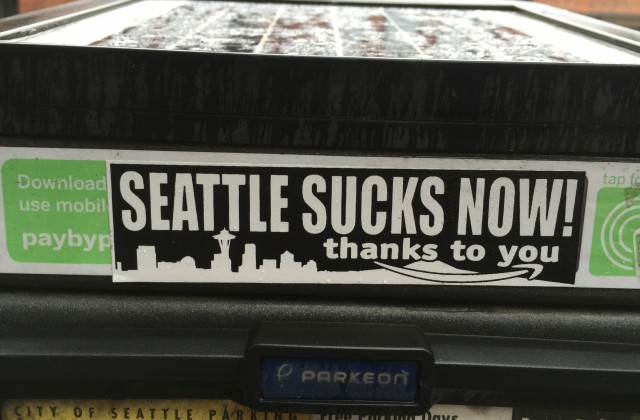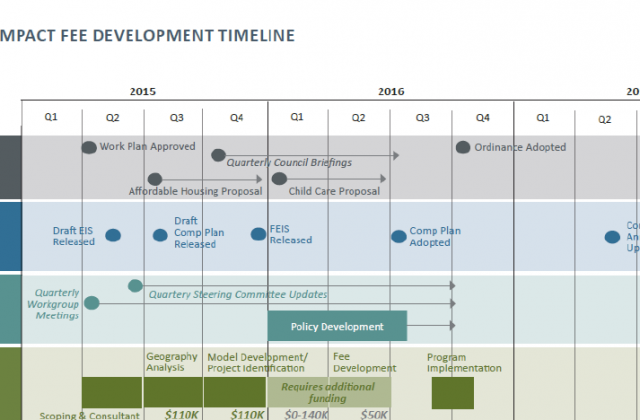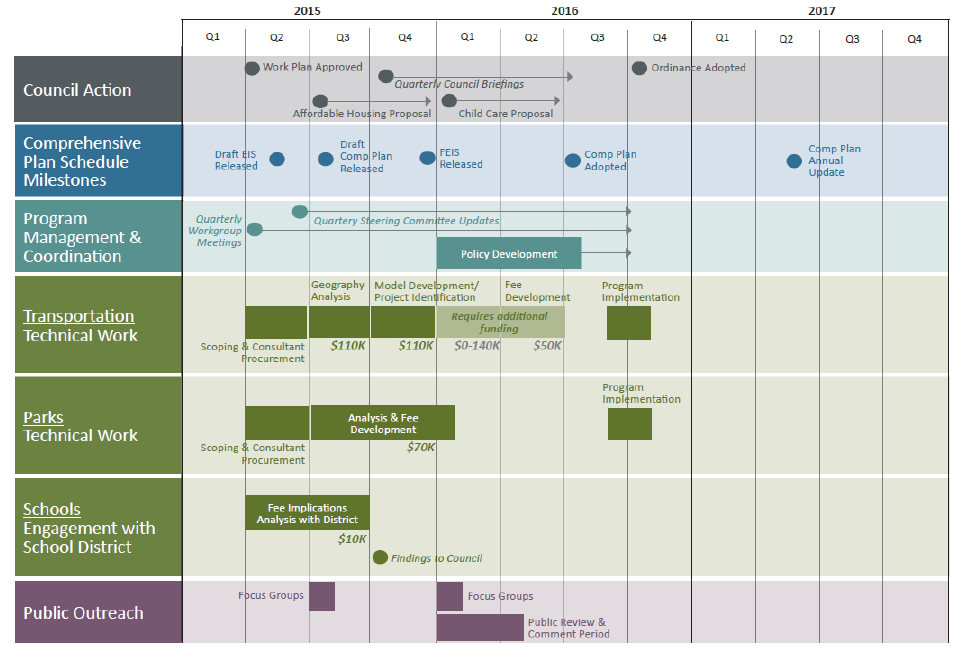Seattle Times’ Self Parody and Learning to Tell a Better Story
There are some stories that write or tell themselves. Think of the story of Goldylocks and the three bears, or Little Red Riding Hood. Then there’s the one about how Seattle is suffering under the great strain and burden of new people coming here. Same old story, same protagonists and antagonists, and the same outcome: greedy people from outside trying to take away everything good about our city. Some people agree with me that this is a myth that must be destroyed if we are to make progress on building more housing. Hearing the story over and over again gets old, and the Seattle Times keeps playing the same old serial again with, As Seattle Grapples with Growth, a Question: Whose City is it? As the lights go down you know exactly how this story is going to go, right?
It’s all there. Greedy developers. Feckless planners stumped at how to control runaway growth. Baffled and frightened people of color (POCs we’ve been called lately). And of course, the wistful strains of “things used to be different.” There’s an Onion parody that editors at the Times should read about vanishing Burger Kings. I think they’d be so embarrassed they’d want to hide.
CLEVELAND—Every day, 38-year-old Susan Tarsley takes a brisk walk through her tree-lined neighborhood. At each turn, she is reminded of the changes brought on by the march of progress: a TV antenna dismantled to make way for underground cable, passersby chatting on cell phones, a rusty tricycle abandoned for a Razor scooter.
But at the silent corner of Lark Street and Superior Avenue, Tarsley stops to mourn the passing of an especially treasured landmark. Her local Burger King is fading into memory. It’s a sadly familiar picture in many communities: Fast-food hubs that once bustled with activity, when young and old alike gathered in plastic molded seats around gleaming yellow linoleum tables, are now boarded-up ghost restaurants. Their long-extinguished drive-through menus silently beckon to cars that will never come.
What makes The Onion article funny is, as Homer Simpson would say, “It’s true!” Everyone’s read the same story over and over again. It’s why the parody works. It’s also funny because, like all good parody, there is a sense of something going too far or to excess. The Seattle Times story is almost a parody of itself. The photographer even creates “ghost” images of places being “lost to change.”
Planners at the City and builders would be shocked to find out that
Until now, in some cases development has been done in a seemingly slapdash manner, resulting in unintended negative consequences, such as traffic congestion and strains on parking. There’s also the issue of older, smaller, more affordable apartment buildings being demolished to make way for all those new, tall, generally more expensive ones.
Yep, all this growth has been happening willy nilly. It’s a free for all. Sure, small-lot development in single-family neighborhoods has been limited, microhousing has been effectively shut down, and low-rise zones effectively down zoned. And more and more requirements are being added and existing ones reinterpreted to protect single-family home owners. Yes. Slapdash. The myth becomes reality in land use and housing policy.
And,
Even with ostensibly good intentions, though, there’s always a project, proposal or policy that causes major blowback.
Case in point: Last summer, Times columnist Danny Westneat reported that the mayor’s housing affordability advisory committee, mainly made up of developers, legal experts and community-organization leaders, was considering recommending heavy restrictions on single-family zoning to accommodate more duplexes, triplexes and other multifamily construction, to help temper rising housing costs. Among other things, the news stirred up old suspicions in Seattle about the influence of property developers, who have an obvious financial interest in any growth plans, over public policy. The idea was soon tabled.
Yes. “Heavy restrictions on single-family zoning to accommodate more duplexes, triplexes and other multifamily construction.”
Huh? Heavy restrictions? Does anyone edit this stuff? The heavy restrictions is what’s making housing more expensive and boosting the wealth of largely white, entitled, and aging single-family home owners. Meanwhile everyone else gets locked out of owning a home or living in a single-family neighborhood, a zone that dominates Seattle’s land use.
I wish these writers and editors would try, for once, something new. Talk to the many, many people who are struggling to make ends meet but are happy here because they are better off than they were before. How about a story that highlights their hopes and plans here in our city. How about hearing about how this city welcomed them and invited them in and is encouraging them to keep at it and helping them achieve their hopes and dreams. Doing otherwise contributes to the idea that somehow building housing is a bad thing that needs to be punished, a view that only makes life worse for newcomers and natives alike.
Here. I’ll start writing it for you.
Julie Wilson left her home in Pensacola, Florida and moved to Seattle with her girlfriend just a year ago.
“That place wasn’t for us,” says Wilson. “I gets old getting stared at all the time just walking into a restaurant.”
Wilson is white and her girlfriend is black.
“We came here on a vacation and it felt like home, almost right away,” says Wilson. “Before I knew it I had a lead on a job and a couple offers of places to stay while we figured things out.”
Wilson and her girlfriend stayed. Both found jobs at local restaurants. Wilson is an aspiring chef and has enrolled in a program at South Seattle College to hone her skills. Meanwhile her girlfriend is completing some prerequisites to start an engineering degree.
“It’s not easy,” notes Wilson. “Seattle is expensive! But we’re making it work and I feel hopeful because the people here are awesome, loving and welcoming. Everywhere I go I get encouragement and support.”
After a long day at school at work the couple will often hang out at a local bar with friends and plot opening a new restaurant.
“With so many people moving here from around the country, there’s lots of opportunity,” she says noting the growth of Seattle’s tech boom. “Those guys at Amazon are making decent money. And they have to eat.”
Okay. Now go finishing writing that story. Of course you could ask the hypothetical couple the question, “How is your struggle with the housing crisis going,” or “How hard is it to live in Seattle now that it is so expensive?” There is no doubt living in Seattle, or anywhere, can be a struggle and a challenge. For some, poverty is an ever present limit on everything thing life and a looming threat. For others, struggle is part of success and meeting it can be an opportunity for community and collaboration. It all depends on the questions you ask and how you tell the story. Local writers need to work harder not to find examples of happy people, but on framing their stories in a way that reflects possibility not an assumption of misery.
Seattle Magazine on Tower Spacing: Rich People’s Views or More Housing?
I’ve already written about Councilmember Sally Bagshaw’s self serving efforts to squash more housing construction downtown with a tower spacing scheme. Now Seattle Magazine has an article about the fight brewing downtown about allowing more height and lot coverage. The problem with Bagshaw’s efforts, along from being a weird conflict of interest and possibly limiting housing downtown, is that it’s one of the first efforts to unravel the Mayor’s Grand Bargain on housing. The Bargain is supposed to be all about upzones in exchange for rent restrictions. But how’s that going to happen if Bagshaw gets her way. But she’s just going after downtown, right? Nope.
“It’s not just downtown, and it’s not just high-rises,” says Bagshaw. The city is “really trying to push more towers and more housing near the light rail, for example. If we’re putting in mid-height buildings that are just on top of each other, lot line to lot line, you lose some real charm in the city. It’s so critical for there to be room to breathe.”
So, as we frequently do, we have yet another Councilmember who can’t make good policy because she is trying to make a narrow, angry, and entitled group of her constituents happy. The right answer to people worried about their views is what one of my coaches in elementary schools used to say: “That’s life in the big city!” Get over it Escala millionaires! There are lots of other people that want to share the great beauty and opportunity here in Seattle. Not only that, we made a Bargain to create more housing for those people.
I don’t expect Councilmembers to show that kind of backbone anytime soon, but we’ll see. But Councilmember Bagshaw’s comments cast even more doubt about whether the Grand Bargain can survive yet even more compromising with neighbors who are likely to oppose the upzones that the Bargain requires.
Eggs, Bacon, Toast, and an Argument About Housing
There is a regular breakfast get together hosted by a Smart Growth Seattle supporter who owns and operates numerous rental properties on Capitol Hill and around Seattle. The breakfast is a chance for some people in the housing business to get together and talk informally about what’s going on in Seattle’s housing market. This week the breakfast took a bit of dramatic turn, but what unfolded was a microcosm of the larger housing discussion in Seattle.
The breakfast, which usually takes place a Capitol Hill café, started out the way it usually does, with lots of catching up about the news, politics, and people’s stories about how their work is going. One of the regular attendees was facing a serious issue with his bank; without going into lots of detail, the bank was changing the terms of a loan. The reason? Lots of data and news stories are pointing to what most in the business call, “a softening market.”
I’ve written about this before. Rents go up and rents go down. The change is a function that is largely driven by three factors, costs of construction and financing, demand for housing, and housing inventory. If costs are up, demand is up, and inventories are down then rents are high. When demand starts to slow and there is a lot of supply rents start to fall. When this happens banks and lenders can start to get nervous. They worry that the market is cooling and that they won’t get their money back from an investment in housing.
This uncertainty telegraphs through the market. People start talking about sitting on their hands. Waiting it out. Standing pat. All the things that would mean fewer project proposals, fewer loans and investments being made, and then, because of all this worry, ever fewer projects, loans, and investments. It’s how markets work, when people start worrying, confidence erodes, and building slows.
There was a bit of commiserating around the table, and I reprised my old Seattle Transit Blog post about where rents come from. Some people might feel some schadenfreude at builders and landlords talking about a slowing market. After all, maybe their profits will suffer. But as we talked, we all shook our heads collectively at the idea that somehow attacking rising rents with more fees and costs would work. We all know that if rents are going up, the worse thing to do is add costs. If demand stays steady, and supply weak, then people have to pay more for rent, and those higher rents are what pays for the fees, fines and taxes added to housing costs.
Ironically, just as the table was wrapping up a conversation about how cooling demand and possible excesses in supply were going to lead to lower housing prices in Seattle two young men, recognizing me from across the room, approached the table.
One of them wearing a plaid shirt over a black rock and roll t-shirt looked at me and asked, “You’re against rent control, right?”
The guy standing next to him was holding up his phone, taking video of me and waiting for my answer.
“Yes, I am,” I said.
“Why,” he asked.
“Rent control is an inflationary policy,” I started. “While it might work well for the few people that end up in a rent controlled unit, the price of everything else goes up because there is a disincentive to build more housing.”
I looked into the cell phone camera. The guy in the plaid had said that the cameraman was a journalist. He stood there intently staring at his phone, filming me, while we argued about rent control.
“What’s your solution then,” he asked.
I explained, “The best thing we could do is build more housing everywhere, of all kinds, all over the city, for people of all levels of income.”
“My Grandparents were Holocaust survivors and sold pencils,” plaid guy said, “And if it wasn’t for rent control in New York they never would have made it!”
He described how his grandparents ended up being able to buy a home, escape poverty and build a good life for his parents. All because of rent control.
The cameraman asked a question about an easement in Columbia City.
“My brother lives in a small apartment in Columbia City but because of greedy developers wanting an easement he’s losing his home,” the cameraman said.
I didn’t understand what the issue was and said I’d need to know more detail. Then he stomped off.
“He’s really mad,” plaid guy said. “I don’t really know what he’s doing or what he’s working on, or what his name is but he’s really mad.”
The guy kept at it, standing at the side of the table angrily arguing with me about rent control and supply and demand. He was also upset about the changing character of the Capitol Hill neighborhood and the what he saw as the rampant destruction of older, one story buildings. He never did tell me what his name was, so I stuck out my hand and introduced my self. He shook my hand and told me his name.
By this time, the waitress asked him to stop.
“My guys here are just trying to have breakfast,” she pleaded
So I slid over and the guy sat down next to me and kept arguing, a little bit more subdued now but no less angry and upset. My other table mates sat there wide eyed while we continued and I tried to explain that there are good ideas for subsidized housing like using the City’s debt capacity for building on City owned land. I said Councilmember Sawant and I agreed on this but that the City Council hadn’t done anything about it; they were too busy trying to find other ways to add costs to housing.
I also said maybe a transfer of development rights (TDR) program might preserve the one story buildings he was worried were being demolished to make way for housing; you pay off the owner of some of those buildings by letting her sell the floors she doesn’t build to someone else who can build more housing on a parking lot. The best thing we could do, I suggested, was allow as much housing as possible and then come up with fair, broadly distributed property tax levies, like the one we already have, to help offset housing costs for poorer people and families.
He seemed a bit surprised that I engaged him for so long and with a variety of ideas about how to solve the problem. But he didn’t like the fact that the waitress tried to censor him.
“Even this place is just a hipster dump,” he said. “In New York we can argue like this, but here, my God, you argue and everyone gets upset.”
Finally the guy left.
When he was gone, the waitress came back and said, “All this stuff about bartenders getting priced out is nonsense. I own a condo. I worked hard and saved. I do well. But I earned it.”
She explained that she was 35 and had worked hard for what she had like most of the people in the business. She couldn’t understand why people expected to be saved by rent control.
“As I get older I become more and more of a Republican,” she said.
So there it is, all before 9 in the morning. Just another day on the front lines of the housing battle here in Seattle. I joked with the developers at the table, “I do this so you don’t have to.” And it’s the truth; I enjoy engaging people in the topic, anytime and anywhere.
The other thing that is true is that the angry from New York is right: we do have to deal with a lot of emotional arguing on this topic. If we try to avoid it by just saying what people on the other side want to hear, we’ll never make any progress. So whether it’s with strangers at a breakfast table, anonymous commenters, people in the business, City Councilmembers and staff, or friends of friends, I’ll never avoid the conversation about what we need to address the challenges of growing our city: more housing, of all types, everywhere in our city, for people of all levels of income.
Are Impact Fees Better than Linkage Taxes and MIZ?
Before this post even gets started let me say that we are unequivocally opposed to impact fees in the city of Seattle. There are two reasons for this. The first is that by their nature impact fees just add cost to housing and currently all housing development in the city already pay extraordinary amounts towards public benefits. Every time new housing gets built surrounding infrastructure improves, by mandate, and other fees and taxes collected are used for wider public benefit. I’ve written about this before and there is a significant cost and hassle absorbed by new construction to improve local infrastructure. The second is that the City of Seattle has demonstrated a profound inability to make good policy, choosing simple, sledgehammer solutions that appease mobs of angry enfranchised single-family neighbors at the expense of new people moving to our city.
But of all the bad ideas[1] in the bad idea factory that is City Hall, it’s quite possible that impact fees might be the least bad. Here’s why.
First, impact fees are legal. The idea that a new development, of any kind, creates demands on local infrastructure that the public ends up paying for and that should be offset, has been extensively litigated. And in spite of our deep opposition and suspicion about the competence of City staff to implement impact fees, we do not argue that there are some things that are reasonable to expect when growth occurs. As I have pointed out before, builders are already paying for infrastructure, related and unrelated to their projects. Most builders would likely agree that paying for street restoration and new sewer service is a reasonable cost to bear; it is a cost of development that always, however, gets folded into what the renter or buyer pays for housing. More on that later.
Second, contrary to what NIMBYs believe, impact fees are very limited in scope. This is part of why they are legal. A very useful source of information on impact fees in Washington and how they work can be found at the Municipal Research Service Center (MRSC), a great resource on many land use and housing issues. Here’s a solid and straightforward paragraph on impact fees in Washington State from the MRSC website:
In general, an impact fee is a fee charged by a city or county to developers to pay for the costs of providing public facilities or of improving existing ones needed as a result of the new development. Developers are generally responsible for the entire cost of on-site improvements within the development that primarily serve residents of a specific project. Impact fees are a mechanism for assuring that developers pay a pro rata share of the costs of off-site facilities (system improvements) that serve the development. In addition, an overview of selected sources of public facility financing other than impact fees is provided (emphasis is mine).
Impact fees must always be project related, be related and fairly priced based on value added both to the public and the users of the new development. From the MRSC website:
Setting fee schedules for impact fees is a complex process typically involving rate studies; generally, impact fees do not recover the full cost of a new facility since these fees must be directly and proportionately related to impacts associated with new development.
This is what has been extensively litigated and therefore established in law. It means that the fees associated with new development won’t pay for the full cost of infrastructure and they must be connected with the established infrastructure needs to serve the development being charged the fee. Impact fees are not a blank check to fill a local governments general fund; think of a road that gets built to serve a new housing development. And that road wouldn’t be fully paid for by the development because it also benefits the wider public, not just the people benefiting from the new housing.
So a legitimately established regime of impact fees would be something that might be welcomed by builders and developers as an alternative to the many fees and other requirements they face when building housing. Additionally, there is a lot of law that ensures that whatever charge gets levied against a new housing project it will benefit that project and the costs will be shared with the public. The idea is that elected officials would thoughtfully consider the utility and disutility of adding costs to projects with the commensurate increase in housing prices. A smart City Council would weigh the fee’s impact on housing price against public benefit; if one outweighed the other, they’d impose or not impose the fee accordingly.
But we have a City Council that has failed to demonstrate that it has this capacity to make good policy. Rather, they have consistently sought out ways to stick their ladle into private projects in the hope of bringing up gravy that they can distribute to poorly defined groups of people who they say need various forms of housing subsidy. Worse than that (because Robin Hood after all was just trying to help!), they have bought into the notion that housing is a bad thing, the production of which must be punished since it somehow benefits greedy developers and avaricious tech workers who are “driving up the price of housing” and running all the locals out of town.
In conclusion, while impact fees are legal we already have a Council and Mayor that have embarked on numerous other poorly motivated and conceived policies that are sure to add to the troubles of people looking for housing priced affordably for their needs. Mandatory Inclusionary Zoning, linkage taxes, destroying microhousing, limiting small-lot development only are the beginning of a litany of backward, pandering, and economically bad and infeasible policies created by people who simply won’t accept basic economic truth: more costs and fewer units means higher prices. Now and again, like a fevered patient in a hospital bed, staff will now and then have a lucid moment from the Populist Progressive Pox, and recognize this reality. But the realization is fleeting, then we descend back into calls for developers to “pay their fair share.”
Perhaps the time will come when the City of Seattle could be trusted to impose a reasonable, fair, and legal impact fee system to support and encourage growth in our city, but that time isn’t now.
[1] I rarely put footnotes in posts, but I want to make clear that the reason why City Hall has produced such profoundly bad housing and land use regulation is that they fundamentally and willfully mischaracterize how housing is financed. Every idea is based on the concept that there is a lot of “profit” in development, and that each time new housing is built, that the housing creates net negative effects on the community. I won’t write a separate essay here, but when a policy begins with these assumptions what follows is always an exaction of value and punitive. An exaction because in the estimation of bureaucrats and elected officials, “the builders can afford to pay their fair share,” and punitive because the general view some people who already live in Seattle is that housing makes life worse for them and therefore must be punished.
Impact Fees Rejected by HALA, City Considers Them Anyway
Even though the Mayor’s Housing Affordability and Livability (HALA) Committee rejected them, the Mayor’s office of planning is still moving forward with a very extensive process to implement impact fees in Seattle. As often happens with City process, one part of the City was tasked with a project (put together an impact fee proposal) and even though other events have intervened (the huge HALA process) that project is grinding ahead without consideration of any other elements of what the City has been doing. There is even a big timeline with the passage of an ordinance as the final step.
I was I little bit surprised when the City’s Brennon Staley contacted me to ask whether we could help figure out what other cities around the country do to impose impact fees. I’m not really motivated to help until we get our many other questions answered about Mandatory Inclusionary Zoning and a half a dozen other things the City is pursuing that will add real costs to housing production and thus to housing prices for consumers. Here’s the exchange below. I’ll update if and when we hear back.
——————————————
On Fri, Jan 8, 2016 at 9:33 AM, Staley, Brennon <Brennon.Staley@seattle.gov> wrote:
Roger, as part of the Impact Fee work, we are working with a consultant to put together a comparison of fees charged by various jurisdictions. Overall, we are trying to quantify the cost of all fees that fund system improvements or relate to use of the ROW (in Seattle, those include Impact Fees, MHA, SEPA, System Development Capacity Charges, and Street Use Fees) as well as listing but not quantifying permit or service fees (such as permit fees, inspection fees, connection fees).
The consultant has a good sense of the types of fees that existing in Washington State and where to get information about them in other cities. However, we are also looking at three out of state comparison cities (Portland, San Fran, and Denver). Do you or the MBA have any contacts that might be able help us identify a complete list of the charges that developers would pay in these cities? We want to make sure our comparison is complete. Let me know what you think. Thanks.
On Fri, Jan 8, 2016 at 3:55 PM, Valdez, Roger <Roger@seattleforgrowth.org> wrote:Friday, January 08, 2016,
Hello Brennon,
First, we think it is important to point out that, according to participants, the Mayor’s Housing Affordability and Livability (HALA) Committee considered and rejected impact fees as a tool the City should use to positively impact housing affordability (many agree they has a negative impact on affordability). We wonder why the Mayor is not setting work on impact fees aside while the proposals that were agreed upon are fully vetted and developed. If Council action is needed to suspend this work we urge the Mayor to pursue that first rather than pursue this research further. Even better, perhaps the City should try to coordinate all this work before moving forward in such an uneven way.
Is there anyone in your office or anywhere in the City actually mapping and coordinating how your work on impact fees is related to MIZ, the recently passed transportation levy, the HALA recommendations, and various other housing related studies and code changes in process? Has anyone even made an effort to provide written answers to the 10 questions we sent about MIZ last month? Has a meeting been set to discuss the feasibility issues with MIZ?
Undoubtably, impact fees are legal under the Revised Code of Washington (RCW) 82.02.50 for “Public facilities” as defined in RCW 82.02.090 (i.e. public streets and roads, parks, open space, recreation facilities, school facilities, and fire protection facilities).While impact fees are legal, mandatory inclusionary zoning (MIZ), linkage taxes and such, we believe, are not. While we are opposed to the imposition of impact fees in Seattle, many agree that at least they are, in contrast to MIZ, legal, predictable, and that there is enough case law to hold cities accountable for how they are implemented.
Will the City follow the law and propose fees for public facilities as defined in 82.02.090, pursue a legally and economically questionable MIZ scheme, or both? Why? Does the work of the HALA committee not take precedence over other efforts? Is there any effort to understand how MIZ and impact fees would impact housing prices in the city over time?
Second, thank for calling this “Development Cost Burden Research.” I appreciate that. Development of housing is indeed burdened with many, many costs and many of those costs originate from the City of Seattle and local governments through fees, permitting, Pavement Opening and Replacement Rule requirements, drainage, sewer capacity charges, and myriad of other imposed mandated costs.
Third, can you please tell me who the consultant is and give me his or her scope of work. We need transparency on what you’ve asked the consultant to do, how much they’re being paid, and who the consultant is and what other work they’ve done, where, and what other recommendations they’ve made and to what cities and jurisdictions. We need this immediately and I can’t see why we couldn’t just have that today or as soon as you read this e-mail. Thanks in advance for that. If it’s on line somewhere and I missed it, I apologize, but could you point me in the right direction?
We’d also like to see and be briefed on the work as it has gone so far. That is, you say you’re quantifying “the cost of all fees that fund system improvements or relate to use of the ROW.” We need to see what your first take is on that and see if it matches our experiencebefore this moves into the legislative sphere. Once your material moves forward, we think we’d have a hard time trying to true it up to our experience. My guess is that the estimate is pretty spot on from your end, we’d just like a chance to check it out and if there is disagreement, note it.
And why would your research only list but not quantify permit or service fees? These are an enormous cost burden, and I think it would present a less than fair picture of the private resources already going into supporting infrastructure needs all over the City. I have seen you include, for example, the Real Estate Excise Tax (REET) which largely funds the Cumulative Reserve Fund (CRF), a resource used broadly for infrastructure needs all over the city. I think it would be inexcusable to not count things like inspection fees, something entirely driven by the City’s needs but paid for by builders, and, ultimately by renters and buyers who will pay more for housing.
I certainly hope the consultant has a good sense of what’s happening in Washington State. But before I can use our resources to help you get information from other cities, we’d like answers to the critical baseline issues I’ve mentioned above that would have, potentially, a big impact right here in Seattle.
Thank you for your patience and working with us on this and thanks for planning to attend our next breakfast meeting next month.
Roger–







